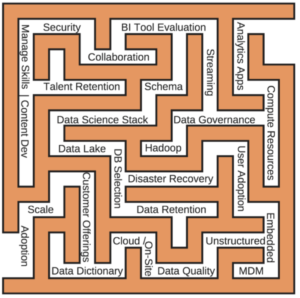It’s an awkward conversation. I sit there across from organizational leaders and ask “So, how many customers do you have now?”, “Maybe 300” one eager person at the table responds. “Wait” another says. “Are you counting customers that have subscribed but not paid yet? What about customers that are being backed out for failure to pay? What about online fraud cases?”. Everyone shrugs as it becomes clear the leadership team hasn’t thought through a way to measure these basic performance criteria. This is an incredibly common conversation when consulting with businesses that are too small to have the resources and support of an enterprise, but large enough to have busy operational demands. Everyone feels awkward because they know this is an answer that informed leaders should possess. This wasn’t a complex calculation, or obscure financial ratio. It was a fundamental question about the status of their business. The truth is, for smaller or mid-sized businesses, basic gaps in organizational tracking are the standard rather than the exception.
The problem isn’t that they lack any raw information or that no one in the organization knows the answer. It is that everyone comes to the answer differently, and therefore they can’t apply a common objective to their strategy. Everyone has different rules for counting based on the challenges in their corner of the business. Everyone includes and excludes values from the count based on different criteria. The problem is that no single source of truth exists in the organization. The executive leadership sees the business differently depending on what they ask.
So many different aspects of today’s business can access helpful data, but the real work of management today is bringing that information together for a common view. Blending data in a coordinated manner forces alignment with strategy and the development of a common vocabulary for effective communication and in the process unifies perspectives. A well-managed business that is prepared to operate effectively needs to understand where it resides and how to anticipate outside influences. Those influences could come from customers, competitors, market forces or even evolving compliance requirements. Businesses are called on to make decisions when environments change, and often in smaller businesses leadership isn’t setup to be informed that their environment has shifted.
Making decisions means answering questions first and that is where the concern for a single course of truth becomes paramount. Every department head must agree at least on the objective criterion that drives these decisions even if they don’t agree on their interpretation or their course of action. To have a single source of truth means agreeing on what information flows and how it is transformed from raw data to enriched and unified intelligence. IT tools and programming environments can dominate this conversation. Unfortunately, many smaller or mid-sized businesses don’t make progress towards a more systematic intelligence because of the daunting array of tools. The marketplace of tools is increasingly crowded and complex, and as soon as organizational leaders start doing online research, they are ringing the dinner bell for a barrage of marketing messages from vendors that want their attention. The unfortunate side effect is that most leaders spend their time evaluating tools rather than defining and implementing sound strategy.
There really is only one thing worth focusing on and that is the system for going from a defined question for the organization to an answer. Blacklight Solutions has spent a decade defining these strategies for mid-sized businesses, and we have learned flexibility in strategy implementation is key. The strategy must make sense within the context of the business in which it is being deployed. Fundamentally however, each strategy needs to illustrate how you go from a well-defined question in the business to answering it as a team. This could mean a simple alert when an operational number crosses a threshold (e.g. a customer is about to get an unusually large bill) or when a complex predictive model determines risk has increased beyond tolerance for the organization’s asset portfolio. The key is to drive answers to these questions systematically as a team. We approach this through the building blocks of data, intelligence and presentation for each organization with an eye towards assembling these blocks in a way that makes sense for the organization.






